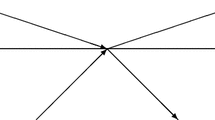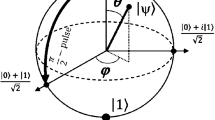Abstract
A “decoherent” measurement is a dephasing plus tracing out plus triorthogonal decomposition. Dephasing can happen any time when a small system is coupled with a large reservoir. It is in principle reversible. But in order to have a measurement we also need the tracing out and the triorthogonal decomposition. The first requirement is observation-dependent (because environment plus apparatus plus object system eventually remain in a superposition). But the second one is an irreversible and irrelative change. In the presence of three “systems” the basis degeneracy problem disappears, i.e. there can be diagonalization only relative to an observable (the measured one).
Similar content being viewed by others
REFERENCES
Auletta, G. (2000). Foundations and Interpretation of Quantum Mechanics in the Light of a Critical-Historical Analysis of the Problems and of a Synthesis of the Results, World Scientific, Singapore, revised edn. 2001.
Breuer, T. (1997). Quantenmechanik--Ein Fall für Gödel?, Spektrum, Heidelberg.
Busch, P., Grabowski, M., and Lahti, P. J. (1995). Operational Quantum Physics, Springer, Berlin.
Busch, P., Lathi, P., and Mittelstaedt, P. (1991). The Quantum Theory of Measurement, 2nd edn., Springer, Berlin.
Cini, M. (1983). Quantum theory of measurement without wave packet collapse. Nuovo Cimento 73B, 27–54.
Davies, E. B. (1976). Quantum Theory of Open Systems, Academic Press, London.
Elby, A. and Bub, J. (1994). Triorthogonal uniqueness theorem and its relevance to the interpretation of quantum mechanics. Physical Review A49, 4213–4216.
Fink, H. and Leschke, H. (2000). Is the universe a quantum system? Foundations of Physics Letters 13, 345–356.
Giulini, D., Joos, E., Kiefer, C., Kuptsch, J., Stamatescu, I.-O., and Zeh, H. D. (eds.) (1996). Decoher-ence and the Appearance of a Classical World in Quantum Theory, Springer, Berlin.
Joos, E. (1996a). Decoherence through interaction with the environment. In Decoherence and the Appearance of a Classical World in Quantum Theory, D. Giulini, E. Joos, C. Kiefer, J. Kuptsch, I.-O. Stamatescu, and H. D. Zeh, eds., Springer, Berlin, pp. 35–136.
Kiefer, C. (1996b). Consistent histories and decoherence. In Decoherence and the Appearance of a Classical World in Quantum Theory, D. Giulini, E. Joos, C. Kiefer, J. Kuptsch, I.-O. Stamatescu, and H. D. Zeh, eds., Springer, Berlin, pp. 157–186.
Lüders, G. (1951). Ñber die Zustandsänderung durch Meßprozeß. Annalen der Physik 8, 322–328.
Machida, S. and Namiki, M. (1980). Theory of measurement in quantum mechanics. Mechanism of reduction of wave packet I–II. Progress of Theoretical Physics 63, 1457–1473, 1833–1847.
Mittelstaedt, P. (1998). The Interpretation of Quantum Mechanics and the Measurement Process, University Press, Cambridge.
Nakazato, H. and Pascazio, S. (1993). Solvable dynamical model for a quantum measurement process. Physical Review Letters 70,1–4.
Namiki, M. and Pascazio, S. (1993). Quantum theory of measurement based on the many-Hilbert-space approach. Physics Reports 232, 301–411.
Omnès, R. (1994). Interpretation of Quantum Mechanics, University Press, Princeton.
Scully, M. O., Shea, R., and McCullen, J. D. (1978). State reduction in quantum mechanics: A calculation example. Physics Reports 43C, 485–498.
Woo, C. H. (1986). Why the classical-quantal dualism is still with us. American Journal of Physics 54, 923–928.
Zeh, H. D. (1970). On the interpretation of measurement in quantum theory. Foundations of Physics 1,69–76.
Zeh, H. D. (1993). There are no quantum jumps, nor are there particles! Physics Letters 172A, 189–192.
Zurek, W. H. (1981). Pointer basis of quantum apparatus: Into what mixture does the wave packet collapse?. Physical Review D24, 1516–1525.
Zurek, W. H. (1982). Environment-induced superselection rules. Physical Review D26, 1862–1880.
Author information
Authors and Affiliations
Rights and permissions
About this article
Cite this article
Auletta, G. Decoherence and Triorthogonal Decomposition. International Journal of Theoretical Physics 43, 2263–2274 (2004). https://doi.org/10.1023/B:IJTP.0000049025.34503.e8
Issue Date:
DOI: https://doi.org/10.1023/B:IJTP.0000049025.34503.e8




